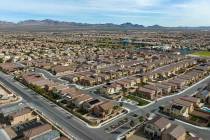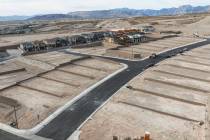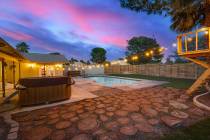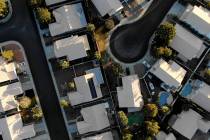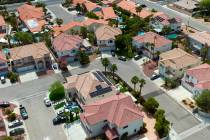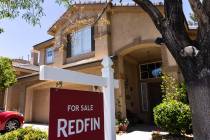With new-home sales weak and financing difficult, local land sales decline
Land sales in the Las Vegas Valley through the third quarter dropped 29 percent from a year ago, to $116.8 million, reflecting weak new-home sales, anemic employment and barriers to access financing, a land specialist said Tuesday.
Bid prices for raw land declined in almost every land-use category except multifamily, which averaged $142,151 an acre for high-density residential, or 14-plus units an acre, Sunbelt Development & Realty Partners reported.
Most of the interest is from multifamily developers in the southwest valley, said Bill Lenhart, owner and broker of Sunbelt Development. He sees land going for $180,000 to $200,000 an acre there in the fourth quarter.
Apartment builders feel the market will be undersupplied as very little development has occurred since 2007, Lenhart said.
"As the housing market goes, so goes the land market," he said. "The value of land is relative to the amount of commerce that can be produced from that property. If it’s a home, the residual land value is the cost and value of the completed home minus the cost of construction."
High-density residential land accounted for $4.28 million in third-quarter sales, medium-density (six to 14 units an acre) $3.12 million and rural residential (one to two units) $431,000. Low-density (three to six units) sales volume was negligible.
It will take apartment builders a couple of years to get zoning changes and permits necessary to start building, Lenhart said.
In looking for ways to keep housing affordable during the boom, county and city planners came up with mixed-use development overlays, or MUD, which allowed a mix of commercial and high-density residential. Multifamily developers want straight apartment zoning, with no commercial, he said.
The bankrupt Manhattan West near the Las Vegas Beltway and Russell Road is an example of mixed-use, podium-style development.
"That’ll never fly now," Lenhart said. "Things change. Prices have gone down and consumer expectations have gone up. They want a normal-size house on a normal-size lot. There’s a flight to quality."
A recovery in the land market is imminent, Lenhart said. However, a return to peak values will not likely occur for at least two market cycles, or 10 to 15 years.
Among third-quarter trends in Sunbelt’s report:
■ New-home sales recorded 16 consecutive months of year-over-year decline, resulting in the lowest postpeak demand for raw land since Sunbelt began reporting land sales in 2008. The land market will not recover before the housing market recovers, Lenhart said.
■ Homebuilders have been forced to abandon lot option agreements negotiated in 2009-10 because sellers were unwilling to restructure terms to reflect the current market conditions. Many of those lots are in the Mountain’s Edge master-planned community in the southwestern valley.
■ Few homebuilders are advancing on land purchases except for select, desirable parcels in strategic markets.
■ Public homebuilders are selling finished and partially finished lots on land that had been bought as raw in the first quarter.
Nonresidential land averaged $291,397 an acre in the third quarter for commercial tourist; $197,257 for commercial; $143,803 for major development projects; $91,846 for industrial; $75,000 for office; and $65,000 for business and design research park, Sunbelt reported.
Lenhart said there won’t be much demand for commercial land, other than from investors and end-users, or those looking to build for their own purposes.
Land sales are historically highest at the end of the year as banks and lending institutions sell off distressed assets, he said. Although fourth-quarter sales may increase, they won’t rise to prior-year levels simply because banks have worked through most of their bad assets, he said.
Contact reporter Hubble Smith at hsmith@reviewjournal.com or 702-383-0491.









